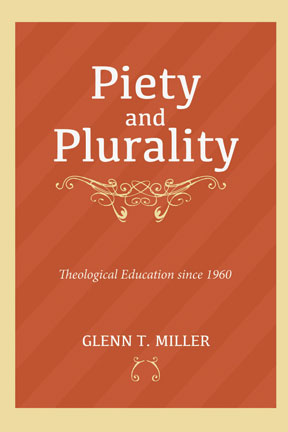
Glenn T. Miller’s self-imposed task was impossible: To find an overarching theme to describe a half-century of tumult in theological education. First in collaboration with Auburn Theological Seminary and then supported by Lilly Endowment, Miller has spent the last 30 years working on a comprehensive, three-volume history of theological education in North America. The first installment, which came out in 1990, he titled Piety and Intellect, and in it Miller focused on the passion to formulate faith in antebellum America.
 |
| Piety and Plurality: Theological Education Since 1960 by Glenn T. Miller (Cascade, 2014, 406 pp., $45) |
The second part in the series, Piety and Profession, was published in 2007. Miller moved the story into the 20th century, focusing on the development of the educated ministry as a modern, credentialed profession.
But what of the third volume, which propels the story from 1960 to the present? Piety and what? Miller chose plurality to summarize the — well, the unsummarizable. He chose not to use pluralism, a word he thinks is politically loaded. But plurality describes the many threads that come together in complex ways in this weighty volume. Some of the topics he covers include:
-
The structure and financing of seminaries.
-
The inclusion of various racial and ethnic groups, as well as gay and lesbian students.
-
The distinct world of Catholic theological education.
-
The crisis of governance in Southern Baptist and Missouri Synod Lutheran seminaries, as well as within evangelical theological education overall.
-
Two sweeping conversations of the 1980s and ’90s: (1) What makes theological education theological? (2) The globalization of theological education.
-
The new professional model — a continuation of the story on seminary structure and finances.
Each of these stories is self-contained, so most readers will find affinities with some chapters over others. Fortunately, readers can dive in and out of chapters at will, enjoying or critiquing each one without engaging the whole narrative.
Presidents, provosts, academic deans, and board chairs will profit greatly from several chapters — the first, second, and seventh — that address the older “professional model” of theological education from the 1960s and chronicle its updates over the following decades. These chapters not only give an overview of the evolution of administrative structures, financial challenges, and program adaptations, but they also explore the shift toward “leadership” as a primary goal of theological education. The closing chapter is also worth close reading, since it gives a big-picture view of the rich contours of theological education, as well as the brisk headwinds that seminaries face.
Chapter 3, on the “rights revolution,” is a fascinating look into the various demands for inclusion that have affected nearly every seminary in the last half-century. Miller’s gift as a story-teller is his ability to describe the parallel struggles for rights within various communities without obliterating each group’s uniqueness. He points out that Catholic, mainline Protestant, and evangelical communities experienced demands for racial, ethnic, and LGBT inclusion differently, but his account is more than a collection of individual narratives. Rather, Miller shows how having different voices at the metaphorical table of theological education has made a difference to many different groups — and to many conversations as well.
As a Protestant, I found the chapter on Catholic theological education to be among the most informative. Miller draws sharp contrast with Protestant theological training, pointing out that there is no equivalent to the Program of Priestly Formation in any Protestant body — nor anything like the apostolic visitations by Vatican representatives to Catholic seminaries. The most important lesson that Miller learned, he says, was that “sacramental formation is not the same as piety or spirituality” — not even among the influential Sulpicians, who run several North American seminaries and who “place a premium on the spiritual life of priests.” In his chapter on governance at Missouri Synod Lutheran and Southern Baptist seminaries, we learn more about Miller himself than in any other chapter (see the footnote on page 221, for example). Miller says up front that he has experienced the Baptist issues personally and painfully, and the whole chapter has a tone and texture that makes it more subjective than the others — and, for my tastes, more compelling.
Set within the wider framework of evangelicalism, Miller draws parallels between the Lutheran and Baptist groups, both of which became more conservative during the 1970s and ’80s as theological moderates departed or were exiled. Miller suggests the Southern Baptists were emboldened by observing the success of the Lutheran battles, but as a Lutheran myself who lived through them, I think that Miller relies too heavily on the Baptist skirmishes as an interpretive framework for the earlier Lutheran family struggles. Nevertheless, Miller does an incredible job of detailing plots and subplots in both battles. At the very least, this chapter should serve as a warning that no matter how large the denomination or seminary, governance matters. And so does theology. Ignoring differences may lead to fractures that are impossible to heal.
Finally, academic deans and faculty leaders can learn much from the sixth chapter, which covers globalization and the question of what theological education really is. By the 1980s and ’90s, Miller says, the “professional model” of theological training, so pervasive in the previous generation, was increasingly seen as insufficient. What emerged, he says, was “the most sustained discussion about theological education conducted since the Reformation.” Miller’s helpful summary of the key issues includes a list of the most important articles and books in which that discussion took place — works by Edward Farley, David Kelsey, Barbara Wheeler, Charles Wood, James Hopewell, Don Browning, John Cobb, Joseph Hough, and Rebecca Chopp, to name a few.
Miller praises the discussions surrounding theological education during the ’80s and ’90s. Many of these conversations had the goal of changing long-held perspectives on the fourfold pattern of the theological curriculum, breaking the culture of clericalism, and finding alternatives to the theory-to-practice model of education. Ideas like theologia and wisdom (paideia), the use of Athens and Berlin as metaphors for educational models, the focus on congregations, and the contextual relevance were widely discussed and debated. At the same time, it’s not clear that the exploration of alternatives has resulted in lasting fruit within the community of theological schools. One reason for the deficiency might be that, according to Wheeler, “the basic issues discussion had no programmatic dimension.”
Miller says that the United States has supplanted Germany as the center for theological studies. And yet the period from 1960 onwards has been marked by fractures and dead ends. The difficulties facing the whole seminary industry — and, indeed, education at large — are legion.
As he demonstrated in the first two volumes of this three-part opus, Miller is a superb historian, but here his involvement has transcended the simple telling of the story. Over the last few decades, Miller has himself been a participant in the events he describes, and he knows many of the players — the actors, the schools, and the events. “I know the best view of earth-moving equipment is not from under the steamroller,” he confesses with some pain. And he helps us, his readers, put his work into perspective. I found his clarifications salutary:
A middle-level source is one written by a contemporary but which references research and sources. It is not quite a primary source, a piece of evidence from an event; nor is it quite a secondary source, written by a third-party observer from research. Midlevel sources are never quite fish or fowl.… So, the reader is cautioned that this is not the final word, not even the penultimate word, on the events and ideas described within [page xi].
Notwithstanding the many qualifiers, this volume — together with the earlier two — has begun the dialogue, shaped the argument, and set the tone for all future work on theological education in America. Its importance cannot be overestimated, especially in the present volatile environment. Miller’s contribution is a mammoth, even breathtaking achievement.